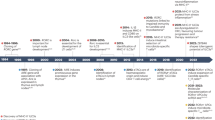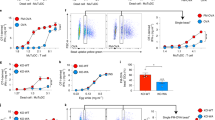Abstract
DENDRITIC cells and thymic epithelial cells perform important immunoregulatory functions by presenting antigens in the form of peptides bound to cell-surface major histocompatibility complex (MHC) molecules to T cells1–3. Whereas B cells are known to present specific antigens efficiently through their surface immuno-globins, a comparable mechanism for the capture and efficient presentation of diverse antigens by dendritic cells and thymic epithelial cells has not previously been described. We show here that their antigen-presentation function is associated with the high-level expression of DEC-205, an integral membrane protein homologous to the macrophage mannose receptor and related receptors which are able to bind carbohydrates and mediate endocytosis. DEC-205 is rapidly taken up by means of coated pits and vesicles, and is delivered to a multivesicular endosomal compartment that resembles the MHC class II-containing vesicles implicated in antigen presentation. Rabbit antibodies that bind DEC-205 are presented to reactive T-cell hybridomas 100-fold more efficiently than rabbit antibodies that do not bind DEC-205. Thus DEC-205 is a novel endocytic receptor that can be used by dendritic cells and thymic epithelial cells to direct captured antigens from the extracellular space to a specialized antigen-processing compartment.
This is a preview of subscription content, access via your institution
Access options
Subscribe to this journal
Receive 51 print issues and online access
$199.00 per year
only $3.90 per issue
Buy this article
- Purchase on Springer Link
- Instant access to full article PDF
Prices may be subject to local taxes which are calculated during checkout
Similar content being viewed by others
References
Steinman, R. M. A. Rev. Immun. 9, 271–296 (1991).
Matzinger, P. & Guerder, S. Nature 338, 74–76 (1989).
Hugo, P., Kappler, J. W. & Marrack, P. C. Immunol. Rev. 135, 133–155 (1993).
Kraal, G., Breel, M., Janse, M. & Bruin, G. J. exp. Med. 163, 981–997 (1986).
Taylor, M. E., Conary, J. T., Lennartz, M. R., Stahl, P. D. & Drickamer, K. J. biol. Chem. 265, 12156–12162 (1990).
Ezekowitz, R. A. B., Sastry, K., Bailly, P. & Warner, A. J. exp. Med. 172, 1785–1794 (1990).
Harris, N., Super, M., Rits, M., Chang, G. & Ezekowitz, R. A. Blood 80, 2363–2373 (1992).
Lambeau, G., Ancian, P., Barhanin, J. & Lazdunski, M. J. biol. Chem. 269, 1575–1578 (1994).
Ishizaki, J. et al. J. biol. Chem. 269, 5897–5904 (1994).
Drickamer, K. & Taylor, M. E. A. Rev. Cell Biol. 9, 237–264 (1993).
Taylor, M. E., Bezouska, K. & Drickamer, K. J. biol. Chem. 267, 1719–1726 (1992).
Drickamer, K. Nature 360, 183–186 (1992).
Bezouska, K. et al. Nature 372, 150–157 (1994).
Daniels, B. F., Nakamura, M. C., Rosen, S. D., Yokoyama, W. M. & Seaman, W. E. Immunity 1, 785–792 (1994).
Taylor, M. E. & Drickamer, K. J. biol. Chem. 268, 399–404 (1993).
Chen, W.-J., Goldstein, J. L. & Brown, M. S. J. biol. Chem. 265, 3116–3123 (1990).
Collawn, J. F. et al. Cell 63, 1061–1072 (1990).
Kleijmeer, M. J., Oorschot, V. M. J. & Geuze, H. J. J. invest. Derm. 103, 516–523 (1994).
Peters, P. J., Neefjes, J. J., Oorschot, V., Ploegh, H. L. & Geuze, H. J. Nature 349, 669–676 (1991).
Amigorena, S., Drake, J. R., Webster, P. & Mellman, I. Nature 369, 113–120 (1994).
West, M. A., Lucocq, J. M. & Watts, C. Nature 369, 147–151 (1994).
Tulp, A., Verwoerd, D., Dobberstein, B., L., P.H. & Pieters, J. Nature 369, 120–126 (1994).
Qiu, Y., Xu, X., Wandinger-Ness, A., Dalke, D. P. & Pierce, S. K. J. Cell Biol. 125, 595–609 (1994).
Boom, W. H., Liano, D. & Abbas, A. K. J. exp Med. 167, 1350–1364 (1988).
Rock, K. L., Benacerraf, B. & Abbas, A. K. J. exp. Med. 160, 1102–1125 (1984).
Lanzavecchia, A. Nature 314, 538–539 (1985).
Piechaczyk, M. et al. Nucleic Acids Res. 12, 6951–6963 (1984).
Inaba, K. et al. J. exp. Med. 176, 1693–1702 (1992).
Author information
Authors and Affiliations
Rights and permissions
About this article
Cite this article
Jiang, W., Swiggard, W., Heufler, C. et al. The receptor DEC-205 expressed by dendritic cells and thymic epithelial cells is involved in antigen processing. Nature 375, 151–155 (1995). https://doi.org/10.1038/375151a0
Received:
Accepted:
Issue Date:
DOI: https://doi.org/10.1038/375151a0
This article is cited by
-
Vaccine adjuvants: mechanisms and platforms
Signal Transduction and Targeted Therapy (2023)
-
Impact of disease-modifying therapy on dendritic cells and exploring their immunotherapeutic potential in multiple sclerosis
Journal of Neuroinflammation (2022)
-
Common and rare variant associations with clonal haematopoiesis phenotypes
Nature (2022)
-
Dynamic regulation of TFH selection during the germinal centre reaction
Nature (2021)
-
Fonsecaea pedrosoi Conidia Induces Activation of Dendritic Cells and Increases CD11c+ Cells in Regional Lymph Nodes During Experimental Chromoblastomycosis
Mycopathologia (2020)
Comments
By submitting a comment you agree to abide by our Terms and Community Guidelines. If you find something abusive or that does not comply with our terms or guidelines please flag it as inappropriate.



